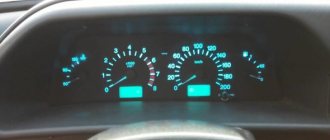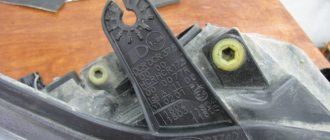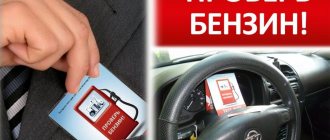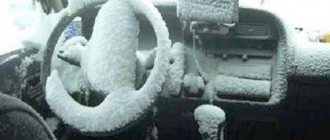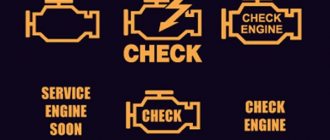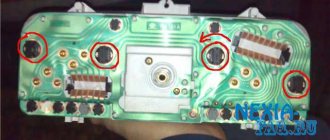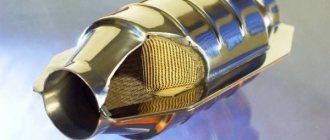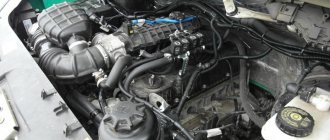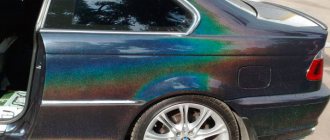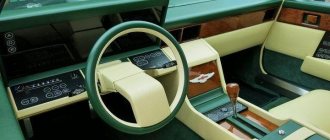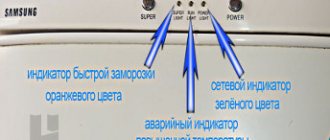A gasoline engine runs on fuel combustion, which is no secret for drivers. There is a special fuel gauge on the instrument panel that informs the driver when he needs to visit a gas station to refill the tank. Gas stations in large cities are located very close to each other, and the driver always has the opportunity to choose where to refuel the car with inexpensive, high-quality gasoline or diesel. However, in the countryside, there may be several tens of kilometers of road between gas stations. If a driver forgets to refuel and a light comes on on the dashboard, he may wonder how many kilometers the fuel in the tank will last.
Types of indicator, principles of operation
On cars with carburetor systems, the warning lamp was powered by a potentiometric fuel level sensor, that is, the sensor and the lamp are connected. The principle of operation is very simple - when a certain level of gasoline is reached, the potentiometer slider connected to the float closes the lamp power contacts. At first, the contacts close intermittently (affected by the splashing of gasoline in the tank), so the indicator flashes, but with greater fuel consumption, the lamp contacts become permanently closed.
In modern cars with an injection power system, the sensor and indicator are separated. The warning light is powered by its sensor mounted on the pump housing. The main element of the signal lamp sensor is a thermistor placed in a metal flask. The principle of operation of the “lamp-sensor” circuit is based on a change in the resistance of the thermistor due to the influence of temperature.
It all works like this: voltage is applied to the thermistor, which causes it to heat up. The fuel acts as a coolant for it; it removes heat, maintaining the temperature of the sensor. If the gasoline level drops below this sensor, the temperature of the thermistor will increase, which leads to a change in its resistance. As a result of the change in resistance, the lamp lights up.
The indicator, built on the basis of a thermistor, is good because it is not connected to the fuel level sensor and works independently of it. This makes it possible to notice a decrease in fuel level even when the fuel sensor is not working.
Is it safe to drive when the fuel level is low?
A car owner who regularly ignores low fuel warnings may face a number of problems. The following may fail:
- catalyst in the exhaust system - repair or replacement will result in large expenses;
- fuel pump - the breakdown is caused by the fact that the fuel at Russian gas stations is not the cleanest. It contains small fractions that settle at the bottom of the gas tank. When gasoline is almost running low, such sediment can get into the fuel system.
In addition, driving with low fuel levels can be simply life-threatening:
- the car may not be able to overcome the rise, especially in mountainous areas;
- If the car stalls in winter far from civilization, you can simply freeze. Such cases occurred not only in the Far East and Siberia, but also in central Russia.
How long can you drive with the light on?
Now let’s talk about how much gasoline remains in the tank if the lamp lights up and how long it will last. This indicator differs for different models. On average, automakers set a reserve of 100 km. That is, the light comes on if there are 5 to 10 liters of gasoline left in the tank, depending on the model. But this does not mean that after the warning light comes on, the driver will drive 100 km. The distance that can be driven on reserve gasoline is affected by driving style, road conditions, engine load, etc. That is, one driver will drive 80-90 km on reserve, while the second will only have enough time for 30-40 km. Therefore, you should not hope that you will drive a long distance on the remaining fuel in the tank. When the indicator lights up, you should immediately head towards the gas station.
How to drive if the gas light comes on
It happens that the gasoline light on the dashboard comes on, but you still have to travel a considerable distance to the gas station. And in this case, measures should be taken to ensure that the reserve is sufficient until refueling. To do this you need:
- Choose a path with a minimum number of stops. Keep in mind that 5 liters of gasoline is not enough to start the car and get to the gas station. A minimum of 10 liters is needed for the pump to fully pump the power system and ensure a stable fuel supply. If there is less gasoline, then the gas pump will “drive” air due to a lack of gasoline, which is why the engine will not be able to operate stably.
- Select a speed mode at which gasoline consumption is minimal (70-80 km/h).
- Reduce the load on the on-board network by leaving only the necessary electrical equipment turned on.
- Close the windows, position yourself behind the truck on the road, this will reduce air resistance to a minimum.
How many kilometers will a car travel if the fuel indicator lights up?
All drivers have been in a situation where halfway through the journey a light came on - a warning about the low fuel in the gas tank. And there is not always a gas station nearby to refuel your car right away. In this case, it is important to accurately calculate your possible mileage so as not to find yourself on the road in a hopeless situation when the fuel runs out. Let's find out how many kilometers you can drive in a car with a glowing fuel indicator.
It is difficult to give general recommendations. Each case is individual. And a lot depends on the make of the car, the type of engine, the general road situation and driving style in general. Where an ordinary passenger car will travel 50-60 kilometers, an SUV, for example, will be able to travel a distance of up to 100 kilometers in the same situation.
And yet, now most modern cars are already installed at the factory with certain sensors that are configured to calculate the exact amount of fuel in the tank; in addition, the instantaneous engine consumption is taken into account. After all the calculations, information about the distance that the car can travel is displayed on the dashboard. And what’s good is that the indicators and all calculations of these systems are quite accurate, so car owners can safely trust it.
So, how long will a crossover or SUV travel with the light on? As a rule, crossovers and SUVs are equipped with a larger gas tank compared to passenger cars. This tank holds 100 liters of fuel or more. And already when there is 10-15% fuel left in the fuel tank, the system notifies the driver about this by turning on the indicator. On the highway, when this warning appears, you can drive up to 150 kilometers, which is quite enough to get to the nearest gas station.
In city conditions, gasoline consumption is much higher due to traffic jams, traffic lights and overall traffic dynamics. When the light comes on in city traffic, the car will travel about 40-50 kilometers, instead of 150 that it would travel on the highway. This example is more than illustrative. On the highway, at an average constant speed, fuel consumption will be approximately 8-10 liters per 100 kilometers, and in the city, under identical conditions, the consumption rate increases to 15-20 liters per 100 kilometers.
As for passenger cars, how long will they travel when the indicator lights up? The gas tank of passenger cars is small in volume, usually 40-60 liters. And, if the warning light comes on when there are 10-15 liters in the tank, then in fact there are 5-8 liters of fuel left in it. In city conditions, with this amount of gasoline, you can drive a maximum of 50-60 kilometers. Therefore, it is very important for the driver to plan his route correctly, taking into account the fact that he will need to refuel along the way. Taking risks in this case is not the right decision, because you can earn a lot of hassle and unplanned expenses associated with expensive cleaning of the fuel system and engine repairs.
What if you run out of gas halfway through the journey? The maximum that many of us think about is that if we run out of fuel on the road, then all that threatens us is a trip on foot with a canister to a gas station. But in reality the problems can be much bigger. The fact is that a lot of dirt and a small amount of water accumulate at the bottom of the tank of any car. And when there is little fuel left in the tank, all this dirt is sucked into the pump and further into the system and injector, and the presence of no filters will help.
Well, here it goes without saying that repairing a fuel pump or cleaning injectors will cost a decent amount. In addition, you will have to pay part of the money for calling a tow truck to move the car to the service center. And yet, it is also not advisable to constantly operate the car in the warning light mode. Because with a minimum amount of fuel, the fuel pump is poorly lubricated and cooled, which also leads to its premature wear and serious breakdowns.
Bottom line. When the fuel remaining indicator lights up, it should definitely be the reason for the driver to refuel the car at a gas station as soon as possible. Naturally, the car will not stop right away, but the fact that different cars have different mileage indicators when the light is on differs in many respects, this is one point, the second is that a small amount of gasoline in the fuel tank can lead to serious problems with various systems, and, accordingly, serious repair costs.
- The American Dream remains a reality. Cadillac introduced new crossovers
See all photo news >>
What are the dangers of running low on gasoline?
Note that it is better not to allow the amount of fuel to decrease to the level where the warning light comes on. If for carburetor cars a small amount of fuel does not have any negative consequences, except perhaps the possibility of an unexpected stop in movement and a “walk” with a canister to the gas station, then in injection cars this phenomenon is dangerous.
The problem is that the fuel pump in such cars is placed in a tank and the fuel for it is coolant. If there is not enough gasoline, the pump motor may fail due to overheating. “Snatching” air with a pump also does not bring anything good.
Another problem is that when the level is low, the fuel pump pumps fuel “from the bottom” of the tank, where debris and dirt accumulate. This leads to a clogged fuel inlet filter, causing the pump to work under increased load, which increases the likelihood of failure.
For the same reasons, constant driving “with a light bulb” is not recommended.
Video: The light comes on, how long will the fuel last?
If the low fuel level sensor lights up on the instrument panel, do you need to immediately panic and rush to the gas station or do you have a couple of kilometers left? And to be precise: how many kilometers can you drive with a light bulb on without “anything being done for it”?
What is backup fuel
This term may not be familiar to every driver, which is why we need to make a small digression and give it an explanation. Reserve fuel is the amount of gasoline that remains in the tank after the light on the dashboard is activated. This level is different for each car; it can differ significantly in cars from different manufacturers. There is no single standard in the world, so each automaker sets the level of reserve gasoline independently.
You can find out how much gasoline remains after the light comes on in a short time. It's very simple, but you do need to have the vehicle's manual handy. Each specification specifies the technical characteristics of the fuel tank. Next to this data there is a number that corresponds to the volume of reserve fuel.
Maybe we should read the manual?
Information about the fuel tank reserve is in the instructions for the car. But, firstly, those who like to read the manual are personnel as rare as Amur tigers. Secondly, everything is written so generally that it is of little use. For example, the exact phrase from the instructions for the KIA Rio and Hyundai Solaris: “The low fuel level indicator light comes on when the fuel tank is almost empty.” Not very constructive, but with a hint of threat: “Running out the fuel supply could endanger the people in the car.”
Meanwhile, Solaris or Rio still has 7–8 reserve liters left in the tank.
Manufacturers of Renault Duster, Renault Logan and Lada Largus are guilty of similar vague phrases: “If the lamp lights up and does not go out, you urgently need to fill the tank with fuel.” But in the same Renault, only Sandero, it is clearly stated: “From the moment the warning light first comes on, you can drive another 50 km.”
And although the instructions for Vesta contain a mention of a control lamp, the topic is not developed further. It’s a different matter with the Volkswagen Polo or Skoda Rapid: the manual directly states that the Polo will travel another 80 km, and the Rapid – all 100.
Is the range shown on the car's on-board computer accurate?
Many car owners often rely on the vehicle's on-board computer, which shows you the possible range. Therefore, some drivers bring the car to a low fuel level, relying on the on-board computer indicator, believing that the indicated range is true.
Also, many drivers, when a warning about low fuel level appears, immediately look at the on-board computer readings in order to find out how much longer the car can travel on the fuel remaining in the tank (power reserve).
But unfortunately, the range isn't accurate because it's only based on the average of your past driving on the road.
The fact is that the car’s electronics will not be able to show you the true range, since it cannot take into account in real time your current driving conditions that affect the consumption of gasoline or diesel fuel.
For example, if you were driving on the highway before a light appeared on the dashboard warning you about the low fuel level in the car tank, and now you are stuck in a traffic jam, then the range displayed on the on-board computer is actually incorrect, since this indicator is calculated using driving on the highway, where fuel consumption is actually much less than in heavy traffic in the city.
What happens if you always forget to fill up? Consequences from which we would like to protect you.
Fuel “hunger” is bad and fraught with “unpleasant adventures”:
if the fuel pump often lacks cooling, it burns out;
if the fuel mixture is too lean and contains dirty impurities, the catalytic converter suffers greatly;
if, when the engine operates at high speeds, the fuel mixture does not enter it, detonation occurs, followed by expensive repairs;
if you are driving through the mountains, the next climb may not give up.
How far can you get if the light bulb has already “started its countdown”?
The minimum you can count on is 5 liters. In fact, it is more likely 7 liters, which is quite enough for 90 km if you are driving along a country road in a B-class car. Don't panic: you can make it to the nearest gas station. Of course, if you are not in the forest or desert, then the next climb will not be possible.
On country trips, a 5-liter canister with a built-in watering can will not hurt. It is inexpensive and takes up minimal space in the trunk. If you close it hermetically, this will eliminate unpleasant odors in the cabin. Do not use plastic bottles - they are dangerous: they are flammable.
If you doubt the quality of gasoline at the first gas station you come across, but the tank is almost empty, it’s better to refuel.
Fill the minimum amount until you reach a proven gas station where you can fill the tank full. Good fuel will dilute gasoline of questionable quality. BUT! Do not start right away: let it pass for a couple of seconds, then turn on the ignition. During this time, the engine will have time to “rejoice” at the good gasoline.
How much gas is in the tank when the light comes on?
As you can see, in order to find the answer to the question of how long and how far you can drive “with a light bulb,” I studied the operating instructions for the most popular cars in Russia. The data was compiled into a table. Conclusion: the minimum fuel supply that car manufacturers provide us is 5 liters, in most cases it is about 7 liters. This should be enough for at least 90 kilometers when driving on a country road in a B-class car. So there is no need to panic when you see a low fuel light or a written warning that the tank is almost empty - unless, of course, you are in the tundra or desert. You'll make it to the gas station.
To find out where the nearest one is, look at the navigator map by turning on POI and filtering by gas station. No navigator - stop to use your smartphone or tablet. A short stop won't hurt. Of course, it is better to find a network gas station with high-quality gasoline, but if there is no guarantee that one is nearby, it is better not to risk it and refuel at the first one - minimally. When you reach a decent level, fill the tank full and dilute fuel of dubious quality. And wait a couple of seconds after turning on the ignition before starting the engine: let the pump fill with normal gasoline.
A common feature of the champions in terms of efficiency (among them is the Volkswagen XL1, which consumes only a liter of fuel per 100 km) is impeccable streamlining.
We crawl, hobble in the darkness...
How to get to the gas station? Close the windows to improve aerodynamics and turn off the air conditioning if possible (air conditioning is a serious energy consumer). There's no point in turning off the music; she won't eat much. Leave the headlights on too - otherwise you will save on safety, which you cannot do, no matter what happens. You need to move as evenly as possible, without sudden acceleration and braking, in top gear, at a speed of about 80 km/h (not in populated areas). In 2008, our editor traveled to St. Petersburg and back on one tank, driving a 170-horsepower Volvo.
Cruise control is a good tool for saving fuel. You just need to learn how to use it correctly.
To maintain a certain speed, cruise control was invented in the middle of the last century, also known as tempomat, which most cars have today. Cars with new automatic transmissions are, in principle, more economical than cars with manual transmissions - they change gears according to a certain algorithm, and not at random, and are trained primarily to conserve fuel. But even modern cars with manual transmissions (for example, Lada Vesta) have built-in “gear shift prompts” (AvtoVAZ term). And even ancient Zhiguli cars have an econometer that suggests the optimal driving mode. And in the latest generation of foreign cars, as a rule, you can select the appropriate operating mode of the power unit by pressing the Eco button. Use the maximum of available tools. If you can, check the tire pressure and adjust it to the specified pressure (the information can be found on the back of the gas filler flap or on a sign in the doorway). Are you traveling with a box on the roof and a trailer on the tail? To get to the gas station, get rid of both and pick them up when you have enough fuel.
Automotive news from around the world
Drivers will begin to be deprived of their licenses on a new basis. Driving licenses will be equipped with chips. Owners will be forced to get rid of old cars from 2020.
But in general, we wish you never to see the fuel reserve light on, always fill the tank under the cap, and if you sometimes go out of town, keep at least a five-liter canister with a built-in watering can in the trunk. It is inexpensive, 500 rubles, and does not take up much space. If it closes tightly, hermetically, it doesn’t even smell. We do not recommend carrying plastic bottles with gasoline: they are more dangerous than cans. And the car burns to the ground in a couple of minutes.
One last thing: instruction manuals are interesting reading. I recommend it.
Page from the Lada 4×4 (ex-Niva) instruction manual. Everything is clear and extremely clear.
How to make it to the gas station if there is catastrophically little fuel?
Closing the windows will improve the car's aerodynamics. If the air conditioner is working, you will have to say goodbye to it for now, since it consumes gasoline excessively. You don’t have to turn off the music and headlights, especially the latter – road safety depends on them. The movement should be uniform: do not accelerate too much and do not brake sharply.
Today, many cars are equipped with cruise control - this miracle of engineering helps to maintain a certain speed. Automatic cars are more economical than manual ones because they change gears themselves and according to a clear algorithm. Excess cargo does not help save fuel: if you are traveling with a trailer, leave it if possible - then return when you replenish your fuel supply. Don’t abuse your car’s “patience”: it’s better to refuel to the maximum right away, delighting your inner driver with a full tank. Do not delay a trip to the gas station if the level is approaching the light bulb: sooner or later this will still have to be done - and it is better to repair the gas pump sooner than later.
